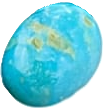
The name turquoise comes from the French word turquois, meaning “Turkish,” referencing its historical trade route through Turkey from Persian mines. Cultures around the world have used this stone for thousands of years.
Various traditions have also referred to turquoise by other names, including:
- Persian Blue – referring to the high-quality deep blue stones from Iran.
- Sky Stone – a name used by Native American tribes, who believed it was a piece of the heavens.
- Callais – an ancient Greek term for turquoise.
- Mecca Stone – a historical reference to turquoise used in Middle Eastern jewellery and religious artefacts.
Composition and Physical Characteristics
Turquoise is a hydrated phosphate of copper and aluminium with the chemical formula CuAl6(PO4)4(OH)8·4H2O. It forms through the interaction of mineral-rich water and aluminium-bearing rocks, often in arid regions.
Physical Properties:
- Colour: Ranges from sky blue to greenish-blue, depending on the presence of copper (blue) or iron (green).
- Hardness: 5-6 on the Mohs scale, making it relatively soft compared to other gemstones.
- Lustre: Waxy to subvitreous.
- Transparency: Typically opaque, though rare specimens may be slightly translucent.
- Varieties:
- Persian Turquoise – Deep blue, high-quality, with minimal veining.
- American Turquoise – Found in Nevada and Arizona, often with a spiderweb matrix.
- Chinese Turquoise – Greenish hues, sometimes enhanced for colour.
- Egyptian Turquoise – Characterised by its striking blue-green shades.
Locations
Turquoise is found worldwide, with some of the most famous sources including:
- Iran (Persia): Producing some of the highest-quality deep blue stones.
- United States: Arizona, Nevada, and New Mexico are known for their turquoise mines, with Native American artisans traditionally using the stone in jewellery.
- China: A major producer, known for its greenish turquoise.
- Egypt: Ancient Egyptian mines in the Sinai Peninsula provided turquoise for early pharaohs.
- Tibet and Mongolia: Valued for their spiritual significance and bright blue-green hues.
- Mexico: Producing high-grade turquoise with unique veining patterns.
Archaeological and Significant Finds
Turquoise has been treasured for millennia, with significant archaeological finds including:
- Egyptian burial sites – The famous golden funerary mask of Tutankhamun features inlaid turquoise.
- Mayan and Aztec artefacts – The Aztecs crafted elaborate mosaics and ceremonial masks using turquoise.
- Native American jewellery – The Navajo, Hopi, and Zuni tribes have a long tradition of crafting intricate silver and turquoise jewellery.
- Persian antiquities – Ancient Persian rulers adorned their crowns, weapons, and palace decorations with turquoise.
Historical and Current Usage
- Ancient Civilisations: Used for jewellery, amulets, and ceremonial objects in cultures spanning Ancient Egypt, Mesopotamia, Persia, and the Americas.
- Protective Amulets: Worn by warriors and travellers to ensure safety and strength.
- Modern Usage: Commonly set in silver jewellery, carved into decorative objects, and incorporated into holistic healing practices.
- Fashion Industry: Popular in bohemian and southwestern-style accessories.
Interesting Facts
- The oldest known turquoise mines, dating back over 5,000 years, are in Egypt’s Sinai Peninsula.
- Native American warriors and hunters wore turquoise for protection and good fortune.
- Turquoise can change colour over time due to exposure to oils, sunlight, and chemicals.
- Some cultures believe a crack in a turquoise stone signals impending danger or misfortune.
Folklore, Legends, and Tales
- Native American Legends: The Apache believed that attaching turquoise to a bow increased hunting accuracy.
- Persian Mythology: Ancient Persians thought turquoise protected against the evil eye.
- Tibetan Beliefs: Used in Buddhist prayer beads, turquoise is said to balance spiritual energies.
- European Middle Ages: Knights carried turquoise as a talisman for invincibility in battle.
Mystical Healing Properties
Turquoise is believed to have powerful metaphysical properties, including:
- Emotional Healing: Promotes inner calm, alleviates stress, and encourages honest communication.
- Physical Healing: Thought to boost the immune system, ease migraines, and aid in detoxification.
- Spiritual Protection: Shields against negative energy and enhances wisdom and intuition.
- Chakra Alignment: Aligns the body’s energy centres, fostering balance and serenity.
Astrology and Zodiac Links
Turquoise is strongly associated with:
- Sagittarius (November 22 – December 21): Thought to bring clarity and wisdom to Sagittarians.
- Scorpio and Pisces: Benefit from turquoise’s protective and calming energies.
- Planetary Ruler: Linked to Venus, fostering love, beauty, and harmony.
Chakra System Connections
Turquoise is connected to multiple chakras:
- Throat Chakra (Vishuddha): Enhances clear communication and self-expression.
- Heart Chakra (Anahata): Encourages compassion and emotional healing.
- Third Eye Chakra (Ajna): Strengthens intuition and spiritual insight.
Birthstone and Wedding Anniversary Links
- Birthstone: Turquoise is the traditional birthstone for December.
- Wedding Anniversary: Associated with the 11th wedding anniversary, symbolising enduring love and protection.
